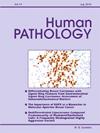血管免疫母细胞 T 细胞淋巴瘤:目前的诊断见解和进展。
IF 2.7
2区 医学
Q2 PATHOLOGY
引用次数: 0
摘要
血管免疫母细胞性T细胞淋巴瘤(AITL),或称结节性T滤泡辅助细胞淋巴瘤,血管免疫母细胞型,是一种罕见的侵袭性T细胞淋巴瘤,具有一系列临床和组织病理学特征,给诊断带来了挑战。AITL来源于T滤泡辅助细胞,其成因被认为是一个多步骤过程,涉及TET2和DNMT3A等表观遗传调控基因的突变,随后是RHOAG17V和IDH2R172的驱动基因突变,这些突变促进了克隆扩增和特征性炎症环境。本综述旨在全面概述 AITL,包括其临床表现、流行病学、发病机制、组织形态学和治疗方案。尽管人们对AITL生物学的认识和新型治疗策略的开发取得了进展,但AITL患者的预后仍然很差。本文章由计算机程序翻译,如有差异,请以英文原文为准。
Angioimmunoblastic T-cell lymphoma: Current Diagnostic Insights and Advances
Angioimmunoblastic T-cell lymphoma (AITL), or nodal T-follicular helper cell lymphoma, angioimmunoblastic type, is a rare and aggressive type of T-cell lymphoma characterized by a spectrum of clinical and histopathological features that can present diagnostic challenges. Derived from T-follicular helper cells, the genesis of AITL is thought to be a multistep process involving mutations in epigenetic regulatory genes such as TET2 and DNMT3A, followed by driver mutations in RHOAG17V and IDH2R172 which promote clonal expansion as well as a characteristic inflammatory milieu. This review aims to provide a comprehensive overview of AITL, including its clinical presentation, epidemiology, pathogenesis, histomorphology and treatment options. Despite advancements in the understanding of AITL biology and the development of novel treatment strategies, the prognosis for patients with AITL remains poor.
求助全文
通过发布文献求助,成功后即可免费获取论文全文。
去求助
来源期刊

Human pathology
医学-病理学
CiteScore
5.30
自引率
6.10%
发文量
206
审稿时长
21 days
期刊介绍:
Human Pathology is designed to bring information of clinicopathologic significance to human disease to the laboratory and clinical physician. It presents information drawn from morphologic and clinical laboratory studies with direct relevance to the understanding of human diseases. Papers published concern morphologic and clinicopathologic observations, reviews of diseases, analyses of problems in pathology, significant collections of case material and advances in concepts or techniques of value in the analysis and diagnosis of disease. Theoretical and experimental pathology and molecular biology pertinent to human disease are included. This critical journal is well illustrated with exceptional reproductions of photomicrographs and microscopic anatomy.
 求助内容:
求助内容: 应助结果提醒方式:
应助结果提醒方式:


